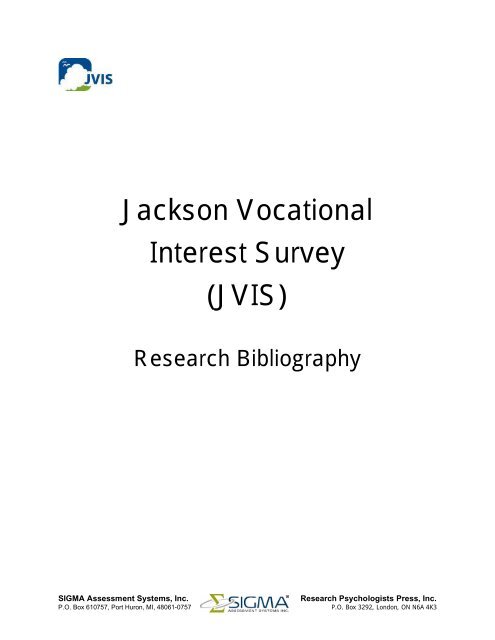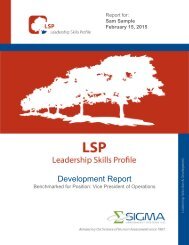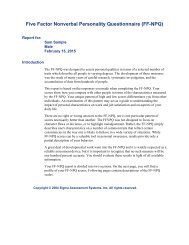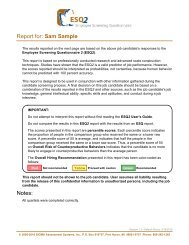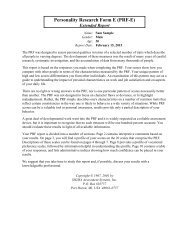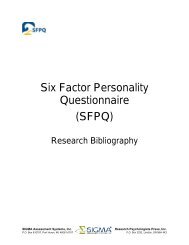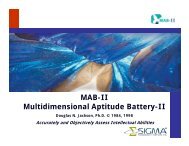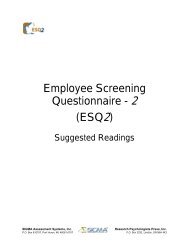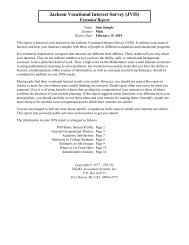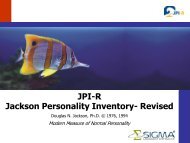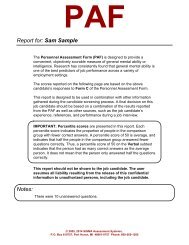Jackson Vocational Interest Survey - Sigma Assessment Systems, Inc.
Jackson Vocational Interest Survey - Sigma Assessment Systems, Inc.
Jackson Vocational Interest Survey - Sigma Assessment Systems, Inc.
You also want an ePaper? Increase the reach of your titles
YUMPU automatically turns print PDFs into web optimized ePapers that Google loves.
<strong>Jackson</strong> <strong>Vocational</strong><br />
<strong>Interest</strong> <strong>Survey</strong><br />
(JVIS)<br />
Research Bibliography<br />
SIGMA <strong>Assessment</strong> <strong>Systems</strong>, <strong>Inc</strong>.<br />
P.O. Box 610757, Port Huron, MI, 48061-0757<br />
Research Psychologists Press, <strong>Inc</strong>.<br />
P.O. Box 3292, London, ON N6A 4K3
JVIS Research Bibliography<br />
RESEARCH BIBLIOGRAPHY – JVIS 1<br />
Adair, J. G., Paivio, A., & Ritchie, P. (1996). Psychology in Canada. Annual Review of Psychology,<br />
47, 341-371.<br />
Anastasi, Anne. (1990). Psychological Testing. (6 th<br />
Publishing Company.<br />
ed.). (pp. 572-575). New York: Macmillan<br />
Armstrong, P. I., Day, S. X., McVay, J. P., & Rounds, J. (2008). Holland’s RIASEC model as an<br />
integrative framework for individual differences. Journal of Counseling Psychology, 55(1), 1-<br />
18.<br />
Armstrong, P. I., & Rounds, J. (2010). Integrating individual differences in career assessment: The<br />
Atlas Model of individual differences in the Strong Ring. The Career Development<br />
Quarterly, 59(2), 143-153.<br />
Armstrong, P. I., Smith, T. J., Donnay, D. A., & Rounds, J. (2004). The Strong Ring: A basic<br />
interest model of occupational structure. Journal of Counseling Psychology, 51(3), 299-313.<br />
Athanasou, J. A. (2011). Advantages and disadvantages of the different inventoried approaches to<br />
assessing career interests. Australian Journal of Career Development, 20(1).<br />
Barak, A. (2001). A cognitive view of the nature of vocational interests: Implications for career<br />
assessment, counseling, and research. In F. T. Leong, & Barak, A (Eds.), Contemporary<br />
Models in <strong>Vocational</strong> Psychology (pp. 97-132). Mahwah, NJ: Lawrence Erlbaum Associates,<br />
<strong>Inc</strong>., Publishers.<br />
Berk, L.A., & Fekken, G.C. (1990). Person reliability evaluated in the context of vocational interest<br />
assessment. Journal of <strong>Vocational</strong> Behavior, 37(1), 7-16.<br />
Betsworth, D. G., & Fouad, N. A. (1997). <strong>Vocational</strong> interests: A look at the past 70 years and a<br />
glance at the future. The Career Development Quarterly, 46(1), 23-48.<br />
Bimler, D., & Kirkland, J. (2006). Testing a “Trilemma” instrument for vocational-interest<br />
assessment. New Zealand Journal of Psychology, 35(2), 99-108.<br />
Blake, R. J., & Sackett, S. A. (1999). Holland’s typology and the five-factor model: A rationalempirical<br />
analysis. Journal of Career <strong>Assessment</strong>, 7(3), 249-279.<br />
Bostan, B. (2010). A motivational framework for analyzing player and virtual agent behavior.<br />
Entertainment Computing, 1(3-4), 139-146.<br />
Bowman, M. L. (2000). The diversity of diversity: Canadian-American differences and their<br />
implications for clinical training and APA accreditation. Canadian Psychology, 41(4), 230.<br />
1<br />
Updated April 2012<br />
- 2 -
JVIS Research Bibliography<br />
Darou, W. G. (1998). The circle game: Shadows and substance in the Indian residential school<br />
experience in Canada. Journal of Cross-Cultural Psychology, 29(6), 766-768.<br />
Gladstone, L., & Trimmer, H.W. (1985). Factors of predicting success in training and employment<br />
for WIN clients in Southern Nevada. Journal of Employment Counseling, 22(2), 59-69.<br />
Hansen, J. C. (2000). <strong>Interest</strong> Inventories. In G. Goldstein, & M. Hersen (Eds.), Handbook of<br />
Psychological <strong>Assessment</strong> (3 rd ed., pp. 203-230). Kidlington, UK: Elsevier Science Ltd.<br />
Holden, R. R., & Marjanovic, Z. (2011). Reaching for the brass ring of psychometric test standards:<br />
Commenting on Slaney, Storey, and Barnes. International Journal of Forensic Mental<br />
Health, 10(4), 284-289.<br />
Hoge, R. D. (2001). <strong>Assessment</strong> within juvenile justice systems. Outreach Scholarship, 5, 153-192.<br />
<strong>Jackson</strong>, D.N., Holden, R.R., Locklin, R.H., & Marks, E. (1984). Taxonomy of vocational interests<br />
of academic major areas. Journal of Educational Measurement, 21(3), 261-275.<br />
<strong>Jackson</strong>, D.N., & Williams, D.R. (1975). Occupational classification in terms of interest patterns.<br />
Journal of <strong>Vocational</strong> Behavior, 6(2), 269-280.<br />
Johnson, J. A. (2005). Ascertaining the validity of individual protocols from Web-based personality<br />
inventories. Journal of Research in Personality, 39(1), 103-129.<br />
Johnson, W., & Bouchard, T. J. (2009). Linking abilities, interests, and sex via latent class analysis.<br />
Journal of Career <strong>Assessment</strong>, 17(1), 3-38.<br />
Juni, S., & Koenig, E.J. (1982). Contingency validity as a requirement in forced-choice item<br />
construction: A critique of the <strong>Jackson</strong> <strong>Vocational</strong> <strong>Interest</strong> <strong>Survey</strong>. Measurement &<br />
Evaluation in Guidance, 14(4), 202-207.<br />
Kapes, J.T. (Ed.), M., & M. Moran (Ed.). (1994). A counselor’s guide to career assessment<br />
instruments (3 rd ed.). US: National Career Development Association, xiii, 137-278.<br />
Li, L., & Wang, L. (2007). Development and validation of the salespeople forced choice behavioral<br />
style test in the information technology industry. Personality and Individual Differences,<br />
42(1), 99-110.<br />
Liao, H., Armstrong, P. I., & Rounds, J. (2008). Development and initial validation of public<br />
domain Basic <strong>Interest</strong> Markers. Journal of <strong>Vocational</strong> Behavior, 73(1), 159-183.<br />
Lima, R., & Fraga, S. (2010). Intervening to help and helping in order to construct: A psychological<br />
intervention model with higher education students. Revista Brasileira de Orientação<br />
Profissional, 11(2).<br />
Lowman, R. L., & Carson, A. D. (2003). <strong>Assessment</strong> of interests. Handbook of Psychology, 467-<br />
485.<br />
- 3 -
JVIS Research Bibliography<br />
Moloney, D.P., Bouchard, T.J., & Segal, N.L. (1991). A generic and environmental analysis of the<br />
vocational interests of monozygotic and dizygotic twins reared apart. Journal of <strong>Vocational</strong><br />
Behavior, 39(1), 79-109.<br />
Murphy, K.R., Davidshofer, C.O. (1991). Psychological testing: Principles and applications (2 nd<br />
ed.), xiv, (pp.514). Upper Saddle River, NJ. US: Prentice-Hall, <strong>Inc</strong>.<br />
Oakland, T. (2009). How universal are test development and use? In E. Grigorenko (Ed.),<br />
Multicultural Psychoeducational <strong>Assessment</strong> (pp. 1-40). New York, NY: Springer Publishing<br />
Company, LLC.<br />
Oliver, L. W., & Whiston, S. C. (2000). Internet career assessment for the new millennium. Journal<br />
of Career <strong>Assessment</strong>, 8(4), 361-370.<br />
Prince, J. P., Most, R. B., & Silver, D. G. (2003). Self-help career assessment: Ethical and<br />
professional issues. Journal of Career <strong>Assessment</strong>, 11(1), 40-58.<br />
Schermer, J. A., & MacDougall, R. (2011). The <strong>Jackson</strong> Career Explorer in relation to the Career<br />
Directions Inventory. Journal of Career <strong>Assessment</strong>, 19(4), 442-451.<br />
Schermer, J. A., & Vernon, P. A. (2008). A behavior genetic analysis of vocational interests using a<br />
modified version of the <strong>Jackson</strong> <strong>Vocational</strong> <strong>Interest</strong> <strong>Survey</strong>. Personality and Individual<br />
Differences, 45(1), 103-109.<br />
Shane, S. (2010). Why that job? The genetic foundations of your work interests. In S. Shane (Ed.),<br />
Born Entrepreneurs, Born Leaders: How Your Genres Affect Your Work Life (pp. 42-67).<br />
New York, NY: Oxford University Press, <strong>Inc</strong>.<br />
Su, R.; Rounds, J., & Armstrong, P. I. (2009). Men and things, women and people: A meta-analysis<br />
of sex differences in interests. Psychological Bulletin, 135(6), 859-884.<br />
Tay, L., Su, R., & Rounds, J. (2011). People-things and data-ideas: Bipolar dimensions? Journal of<br />
Counseling Psychology, 58(3), 424-440.<br />
Taylor, S. (2008). Integrating vocational services within therapeutic community treatment.<br />
Therapeutic Communities, 29(1), 76-82.<br />
Tracey, T. J. (2002). Personal Globe Inventory: Measurement of the Spherical Model of <strong>Interest</strong>s<br />
and Competence Beliefs. Journal of <strong>Vocational</strong> Behavior, 60(1), 113-172.<br />
Viswesvaran, C. (2005). The fifteenth mental measurements yearbook. Personnel Psychology, 58(1),<br />
273-281.<br />
Zarrella, K.L., & Schuerger, J.M. (1990). Temporal stability of occupational interest inventories.<br />
Psychological Reports, 66(3, pt 2), 1067-1074.<br />
Zytowski, D. G. (2001). Kuder career search with person match: Career assessment for the 21 st<br />
century. Journal of Career <strong>Assessment</strong>, 9(3), 229-242.<br />
- 4 -


